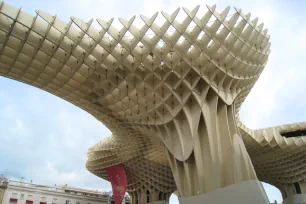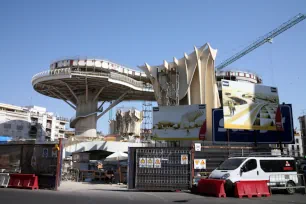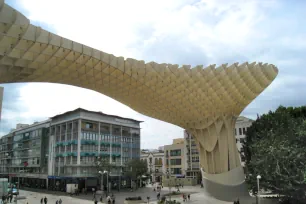Seville is best known for its historic landmarks that date back to its heyday in the Middle Ages. However, the city also has some spectacular modern architecture on offer such as the Alamillo Bridge and the iconic Metropol Parasol, a wooden structure built between 2005-2011 in the heart of the city.
The Site

The Metropol Parasol was built at the Plaza de la Encarnación, a large square in the center of Seville that until 1973 was in use as a marketplace. The following decades, the square was abandoned and used as a parking lot.
In the 1990s, the city council decided to renovate the dilapidated square and build an underground parking garage as well as a new market hall. However, during the initial construction phase, excavations revealed remains of Roman houses and the project was halted. Instead, the city council now wanted to create an archaeological museum, so in 2004 they launched a competition for a redesign of the market square, with the requirement that it should accommodate the museum as well as a market hall. Out of sixty-five participants, a modern design dubbed ‘Metropol Parasol’ by Berlin architect Jurgen Mayer H. was chosen.
Construction

Construction of the Parasol, a large wooden structure covering a large part of the square, started in 2005. It was originally slated for completion in 2007 but technical problems stalled the construction. At one point the structural engineers, of the prestigious firm Ove Arup & Partners, claimed the structure was not technically feasible.
Progress was brought to a standstill and for several years the concrete core of the structure was all that was visible, and the site became an eyesore. Eventually a breakthrough was made, and the design was modified to overcome the technical obstacles. The Metropol Parasol finally opened officially on March 27, 2011. The technical problems however resulted in serious cost overruns at a time when Spain was in a deep recession.
The Structure
The Metropol Parasol is a large canopy-like structure, 150 meters long and 70 meters wide, with a height of about 26 meters (492 x 230 x 85 ft). To protect the Roman ruins underground, the structure rests on just a handful of large pillars, which act like trunks from where the tree-like ‘parasols’ rise. Those parasols provide plenty of shade, a necessity in a city known for its scorching summers. The architect, Jürgen Mayer H, was inspired by the magnificent fan tracery vaulting of the cathedral when he designed the parasols.

The Metropol Parasol is made of concrete, steel and timber with a polyurethane coating, held together with glue. The glue was tested to withstand Seville’s high summer temperatures.
The lower levels of the structure contain the Antiquarium (archaeological museum), a public plaza and a farmers market. Elevators in the concrete columns bring visitors to the rooftop, where winding walkways lead to a platform with magnificent views over the city.
The radically modern design of the Metropol Parasol contrasts with its historic surroundings, and the choice for wood as its main material was a way to alleviate concerns that it was too intrusive. Despite these concerns, it is clear that for the first time in centuries, Seville has a new iconic building that will attract its fair share of visitors.

